Field Judging Elk
By Jay Scott
©Copyright Elk Hunter Magazine
"Saw a big bull yesterday; figure he was over 400." How many times have your heard that? Did you believe the guy who told you? Did he have a method for coming up with that number, or was it just a guess?
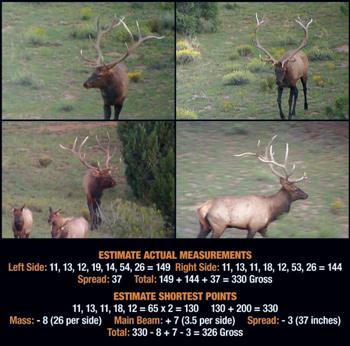
There are several ways to field judge elk; one is to "air judge" - the wing-it approach based on experience and knowledge, and this surely has its place at times. The other is to actually break him down and measure him up by estimating point and beam length, mass, and inside spread. I gained the most consistency and accuracy with my field judging by actually scoring lots of antlers, and with each one, I gained more confidence. I love to field judge bulls and then score them on the ground to see how close my field judging was to the real thing. Oftentimes I score a bull in my head before asking the hunter what it actually scored, but nothing beats getting out a tape and measuring lots of bone. My guesses have been wrong many times, but it's amazing how close you can get from the field estimates to the actual measurements with a little practice.
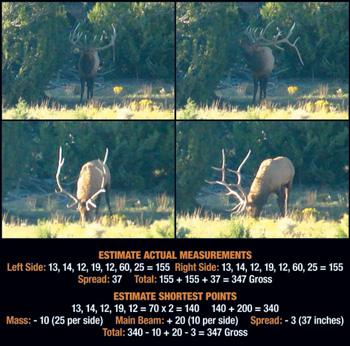
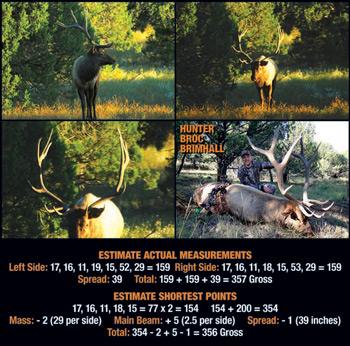
Estimate Actual Measurements
Tines - There are several things I like to do when trying to estimate the actual measurements on a bull elk. First, I use anatomical references to estimate several of the point lengths. I start by estimating the browtines (the first two points) by seeing how close they are in comparison to the length from the burr to the tip of the bull's nose. On a mature bull, that measurement is 15-16 inches. So if the first two points on each side follow parallel with the nose and tip up just at the end of the nose, they should be right around 16 inches. Beware of straight-looking points without much end curve, because they are often shorter than you think. Long browtines will follow the nose and then curl or bend upward (look for at least four inches of curl for a 20-inch tine).
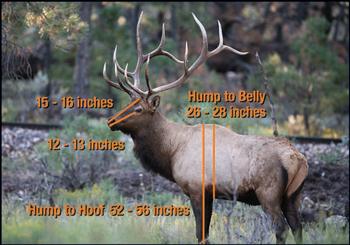
Once I determine the length of the first two points, I then extrapolate those into the rest of the points. The third points are often the source of a bull's weakness; again, look for curl or lots of curve.
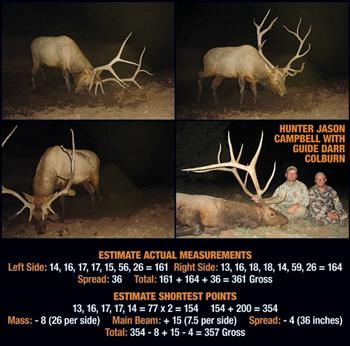
By Jay Scott
©Copyright Elk Hunter Magazine
"Saw a big bull yesterday; figure he was over 400." How many times have your heard that? Did you believe the guy who told you? Did he have a method for coming up with that number, or was it just a guess?

There are several ways to field judge elk; one is to "air judge" - the wing-it approach based on experience and knowledge, and this surely has its place at times. The other is to actually break him down and measure him up by estimating point and beam length, mass, and inside spread. I gained the most consistency and accuracy with my field judging by actually scoring lots of antlers, and with each one, I gained more confidence. I love to field judge bulls and then score them on the ground to see how close my field judging was to the real thing. Oftentimes I score a bull in my head before asking the hunter what it actually scored, but nothing beats getting out a tape and measuring lots of bone. My guesses have been wrong many times, but it's amazing how close you can get from the field estimates to the actual measurements with a little practice.


Estimate Actual Measurements
Tines - There are several things I like to do when trying to estimate the actual measurements on a bull elk. First, I use anatomical references to estimate several of the point lengths. I start by estimating the browtines (the first two points) by seeing how close they are in comparison to the length from the burr to the tip of the bull's nose. On a mature bull, that measurement is 15-16 inches. So if the first two points on each side follow parallel with the nose and tip up just at the end of the nose, they should be right around 16 inches. Beware of straight-looking points without much end curve, because they are often shorter than you think. Long browtines will follow the nose and then curl or bend upward (look for at least four inches of curl for a 20-inch tine).

Once I determine the length of the first two points, I then extrapolate those into the rest of the points. The third points are often the source of a bull's weakness; again, look for curl or lots of curve.

Field Judging Elk - 2
Another anatomical measurement that can be used when determining point length is the distance from the top of the back to the bottom of belly. That measurement is generally about 26-28 inches depending on the maturity of the bull. When a bull is broadside, you can compare his fourth point to that measurement. If the point is six inches shorter, then the bull probably has a 20-inch fourth point. Once you estimate the length of the fourth points, move to the fifths and compare them with the fourths to determine their length.
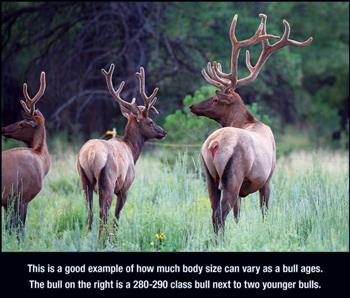
Main Beam - Next, I estimate the length of the main beam by using an important anatomical measurement. When a bull has his head down feeding, I determine whether the main beam is higher or lower than the hump on his back above his shoulder. The distance from that hump down his front leg to his hoof is generally 52-56 inches, depending on the maturity of the bull. If the tip of the main beam comes to the top of the hump then the beam is probably around 50 inches. If it is shorter or longer than the hump on the back, I add or subtract inches accordingly.
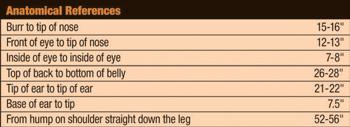
Mass - Determining the four mass measurements per side is usually difficult, so I use a little rule of thumb. If the rack doesn't look heavy and has a thin appearance, I attribute 27 inches of mass per side or 54 inches total. If a bull looks really heavy and solid, then I estimate about 30 inches of mass per side. Trying to determine mass is very hard and requires scoring quite a few racks, but if you use those numbers, you will often be close.
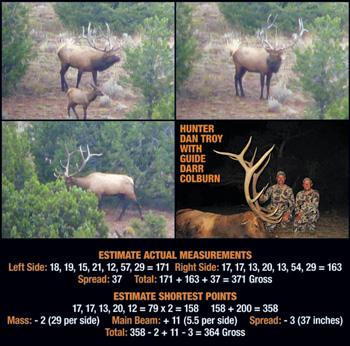
Inside Spread - The last measurement to estimate is inside spread, which is the widest point from the inside of one beam to the inside of the other. I often use two anatomical measurements: 1) the distance from ear tip to ear tip (21-22 inches); and 2) the actual ear length itself (7.5 inches). The only way to really estimate the inside spread of a bull elk is for him to face you. When he's facing you, look at the width of his ears. If you can add one ear length to each side, that should put you at a 37-inch inside spread (22 + 7.5 + 7.5 = 37). If you can add an ear and a half to each side, then the inside spread measures approximately 45 inches. Keep in mind that very few bulls are wider than 45 inches inside.
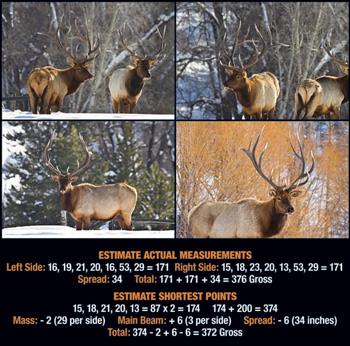
There is quite a bit of "air judging" that gets done while estimating measurements, but if you use anatomical references, you can often get pretty close to the real measurement. Just to be sure, I cross-referenced anatomical measurements with Clay Goldman of Mogollon Taxidermy. You may want to do this with a taxidermist in your area.
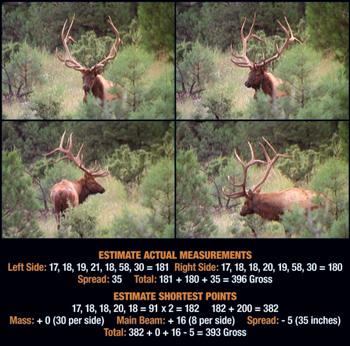

Main Beam - Next, I estimate the length of the main beam by using an important anatomical measurement. When a bull has his head down feeding, I determine whether the main beam is higher or lower than the hump on his back above his shoulder. The distance from that hump down his front leg to his hoof is generally 52-56 inches, depending on the maturity of the bull. If the tip of the main beam comes to the top of the hump then the beam is probably around 50 inches. If it is shorter or longer than the hump on the back, I add or subtract inches accordingly.

Mass - Determining the four mass measurements per side is usually difficult, so I use a little rule of thumb. If the rack doesn't look heavy and has a thin appearance, I attribute 27 inches of mass per side or 54 inches total. If a bull looks really heavy and solid, then I estimate about 30 inches of mass per side. Trying to determine mass is very hard and requires scoring quite a few racks, but if you use those numbers, you will often be close.

Inside Spread - The last measurement to estimate is inside spread, which is the widest point from the inside of one beam to the inside of the other. I often use two anatomical measurements: 1) the distance from ear tip to ear tip (21-22 inches); and 2) the actual ear length itself (7.5 inches). The only way to really estimate the inside spread of a bull elk is for him to face you. When he's facing you, look at the width of his ears. If you can add one ear length to each side, that should put you at a 37-inch inside spread (22 + 7.5 + 7.5 = 37). If you can add an ear and a half to each side, then the inside spread measures approximately 45 inches. Keep in mind that very few bulls are wider than 45 inches inside.

There is quite a bit of "air judging" that gets done while estimating measurements, but if you use anatomical references, you can often get pretty close to the real measurement. Just to be sure, I cross-referenced anatomical measurements with Clay Goldman of Mogollon Taxidermy. You may want to do this with a taxidermist in your area.

Field Judging Elk - 3
Magic Number/Estimate Shortest Points
There is a great shortcut for judging bulls where I use anatomical references, but instead of trying to estimate each measurement individually, I use a magic number for the main beam length, mass, and inside spread, and then I compare the length of the points from one side to the other and estimate shortest points. This method is not quite as exact as estimating each measurement, but it gets you very close and it's much quicker and easier.
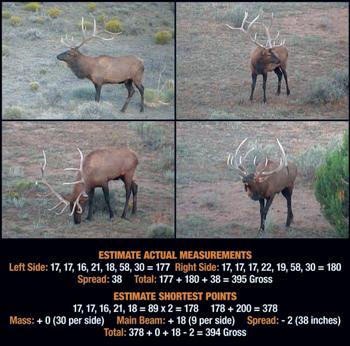
First, I start with the magic number of 200. For a mature typical bull elk that scores around 350 B&C, his main beam length is usually around 50 inches per side x 2 sides = 100 inches; his mass usually equals 30 inches per side x 2 sides = 60 inches; and his inside spread is usually around 40 inches, so 100+60+40=200.
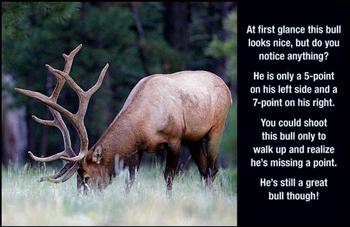
Next, I estimate the length of the shortest point for each antler, double it, and then add them up. Be careful with these estimates, because whenever you double a measurement, it can make your score go up or down drastically. Do your best not to overestimate your shortest points. Now add the total length of points to the magic number of 200 to get the gross score.

Finally, go back to the main beam, mass, and inside spread. Is the main beam really 50" or is it 53"? Is the mass heavy or light and how does it compare to 30" per side? Is the bull really 40" inside or is he 36"? If you think those measurements deviate from the magic number, just add or subtract the differences accordingly.
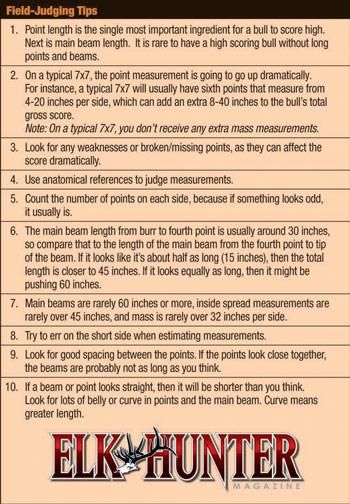
It's an Art
Field judging elk is an art, while measuring dead elk is a science! One of the best ways to improve your field judging skills is to practice field judging bulls before actually measuring them. I hope these scoring methods and tips will come in handy when trying to field judge your trophy bull, but remember, it's more important to measure your hunt success by the memories and quality experience gained than by the size of the antlers you bring home.
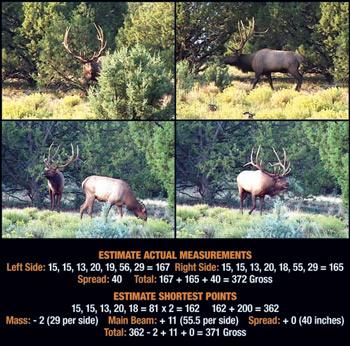
Editor's Note: For more information on hunting and adventure, log on to Jay's blog at www.jayscottoutdoors.com.
This article originally appeared in Elk Hunter Magazine and appears courtesy of Elk Hunter Magazine. Elk Hunter Magazine is THE magazine for the hunter passionate about elk hunting, and is made up of the most experienced, well-respected elk hunters in the industry.
There is a great shortcut for judging bulls where I use anatomical references, but instead of trying to estimate each measurement individually, I use a magic number for the main beam length, mass, and inside spread, and then I compare the length of the points from one side to the other and estimate shortest points. This method is not quite as exact as estimating each measurement, but it gets you very close and it's much quicker and easier.

First, I start with the magic number of 200. For a mature typical bull elk that scores around 350 B&C, his main beam length is usually around 50 inches per side x 2 sides = 100 inches; his mass usually equals 30 inches per side x 2 sides = 60 inches; and his inside spread is usually around 40 inches, so 100+60+40=200.

Next, I estimate the length of the shortest point for each antler, double it, and then add them up. Be careful with these estimates, because whenever you double a measurement, it can make your score go up or down drastically. Do your best not to overestimate your shortest points. Now add the total length of points to the magic number of 200 to get the gross score.

Finally, go back to the main beam, mass, and inside spread. Is the main beam really 50" or is it 53"? Is the mass heavy or light and how does it compare to 30" per side? Is the bull really 40" inside or is he 36"? If you think those measurements deviate from the magic number, just add or subtract the differences accordingly.

It's an Art
Field judging elk is an art, while measuring dead elk is a science! One of the best ways to improve your field judging skills is to practice field judging bulls before actually measuring them. I hope these scoring methods and tips will come in handy when trying to field judge your trophy bull, but remember, it's more important to measure your hunt success by the memories and quality experience gained than by the size of the antlers you bring home.

Editor's Note: For more information on hunting and adventure, log on to Jay's blog at www.jayscottoutdoors.com.
This article originally appeared in Elk Hunter Magazine and appears courtesy of Elk Hunter Magazine. Elk Hunter Magazine is THE magazine for the hunter passionate about elk hunting, and is made up of the most experienced, well-respected elk hunters in the industry.

